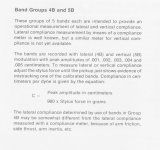Scott's on the right track, no vinyl involved as I have pointed out in other places, but not here.
The people purchasing tape from the tape project and elsewhere are committed audiophiles/music lovers - I know several with extremely deep pockets. I just can't see very many people paying a grand for such a disk - collectors occasionally do for rare/vintage recordings.
I don't see the markets for this disk as being congruent and I suspect that a disk that costs significantly more the current crop of audiophile quality pressings (note I said nothing about sound quality) is probably not going to fly.
It'll be interesting to see if it comes to fruition, and if it does I will have to reappraise based on direct experience. (I'll buy a couple)
One of the touted benefits is the process of manufacture is much greener than vinyl record production which isn't too hard to believe.
Edit: It could be a great technology for making test records..
The people purchasing tape from the tape project and elsewhere are committed audiophiles/music lovers - I know several with extremely deep pockets. I just can't see very many people paying a grand for such a disk - collectors occasionally do for rare/vintage recordings.
I don't see the markets for this disk as being congruent and I suspect that a disk that costs significantly more the current crop of audiophile quality pressings (note I said nothing about sound quality) is probably not going to fly.
It'll be interesting to see if it comes to fruition, and if it does I will have to reappraise based on direct experience. (I'll buy a couple)
One of the touted benefits is the process of manufacture is much greener than vinyl record production which isn't too hard to believe.
Edit: It could be a great technology for making test records..
Edit: It could be a great technology for making test records..
IME it would be a miracle if someone could get out an initial catalog of say a dozen releases at less than $300-$500 a copy. There are lots of indie labels doing runs of 1000 at $15 retail, and there some that sound great. We all have heard existence proofs that great vinyl could even be made in the 60's. It's still vinyl surface noise, ticks, pops, warps and all.
Last edited:
Does anyone have CBS STR-100? I have a couple of questions regarding it.
I have a copy, what are your questions?
Take care,
Doug
Does anyone have CBS STR-100? I have a couple of questions regarding it.
I have a copy right here, what is the question? I also have recording in .wav somewhere.
Thanks. Two questions
1. Looking at the spec sheet for a technics MM I noted that it states that the 100Hz compliance is measured using STR-100. Is there anything in the notes that suggests how this was done?
2. In trying to find a copy of the notes on line in a legible format I came across mention of a wear test track. Any description of that that actually is.
Thanks
Bill
1. Looking at the spec sheet for a technics MM I noted that it states that the 100Hz compliance is measured using STR-100. Is there anything in the notes that suggests how this was done?
2. In trying to find a copy of the notes on line in a legible format I came across mention of a wear test track. Any description of that that actually is.
Thanks
Bill
Thank you.
I don't have a hard copy but the wear test is 20k, 18k, 16k, 14k, 10k and 5k tones on inner most and outer most grooves at low levels. The last audible tones on each set should be the same. At my age it's likely I would only hear the 10k and 5k. This test would clearly be better using a recording of the tracks.
The STR 120 has inner, middle, and outer groove 500-50k sweeps that show the frequency losses better.
Last edited:
Ah good. I didn't think there was anything magic I had missed.
Yes, they don't separate the expected loss from what they call "wear loss". I found another interesting result, the sensitivity to warp/off-center seems to vary a lot with frequency and radius. I'm not sure now if the plots only looking at magnitude show cantilever resonances 20k-50k.
Informative paper on FemtoLaser capabilities and uses.
Maybe not vapourware after all.
Femtosecond laser micromachining: A back-to-basics primer - Industrial Laser Solutions
Maybe not vapourware after all.
Femtosecond laser micromachining: A back-to-basics primer - Industrial Laser Solutions
femtosecond lasers are not vapourware. Cutting a 500m long track with one may be slightly more than has been tried before by a factor of many orders of magnitude.
They are proposing a bit more than that; they are saying the ceramic stampers will be laser cut as "mountains" not "valleys", so a lot of material being removed.
Assuming it works, though, they are eliminating a lot of steps in the stamping process (one stamper of ceramic > vinyl LP vs the lathe cut master > the master stamper > x number of mothers > x number of production stampers > vinyl LP).
Since this is only vaguely on-topic, I won't comment further.
Last edited:
Take a look at this modern record press:
Hand Drawn Pressing on Vimeo
Hopefully you suspect what I am thinking..
Hand Drawn Pressing on Vimeo
Hopefully you suspect what I am thinking..
Hi Kevin, No idea what you're thinking but watched the horse video that followed and then this other Hand Drawn vid came up.
Turns out that the Warm Tone has been sold to more than one producer, in particular a small run specialist in Texas.
More machine videos.
Machine manufacturer's website
More machine videos.
Machine manufacturer's website
- Home
- Source & Line
- Analogue Source
- Test LP group buy
